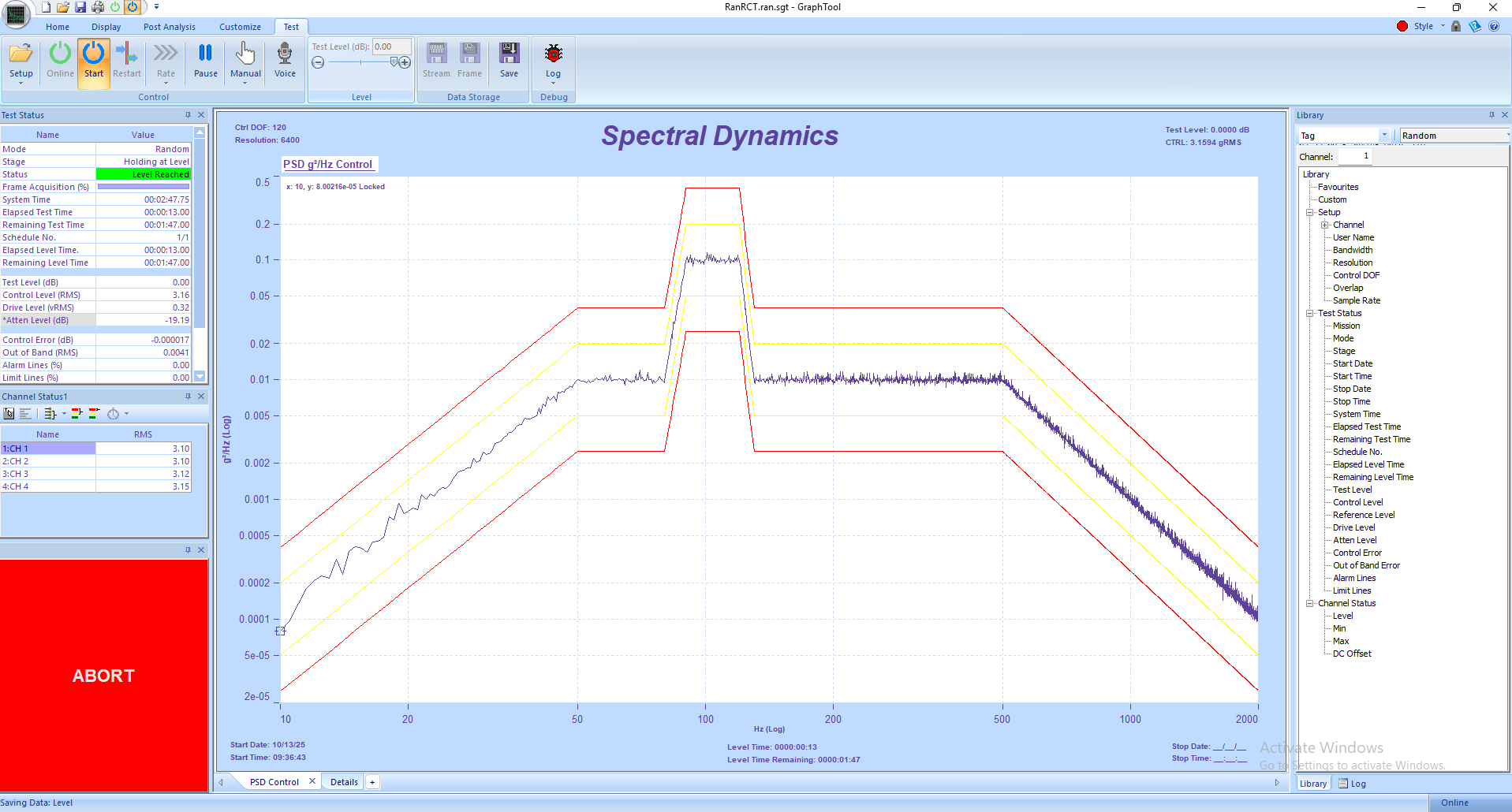Random
Spectral Dynamics invented closed-loop digital vibration control and continues to lead with Panther — the next-generation control and analysis platform that combines precision, safety, and intuitive operation. Panther’s Random Control application builds on decades of engineering experience to deliver the industry’s most accurate, adaptive, and reliable random vibration control solution.

Random Control Overview
Panther’s Random Control provides true Gaussian random generation with precise adaptive equalization for rapid loop closure and stable control across all spectral ranges. Engineers can configure narrowband or broadband profiles, overlay live and stored data, and monitor real-time response with full-resolution spectral plots. The advanced control architecture ensures superior amplitude accuracy and repeatable test results even under complex dynamic conditions.
Key Features and Advantages
• Real-time, gap-free streaming to the host disk for complete data integrity during testing.
• Multiple acquisition streams with independent sample rates for simultaneous capture of high-speed and low-speed data.
• Automated report generation with test summaries, control spectra, and limit profiles for easy documentation.
• Fully touch-screen compatible, optimized for Microsoft Surface and other Windows devices.
• Continuous monitoring of more than a dozen system parameters up to 25 times per second to ensure operator and equipment safety.
• Modern GTX interface provides intuitive setup, execution, and visualization for all random control parameters.
• Flexible configuration of control channels, profile shapes, and equalization parameters for diverse test environments.
• Integrated Library feature for instant access to setups, results, and comparison data without navigating file directories.
• Adaptive control algorithms deliver fast settling times and consistent performance across varying test conditions.
Ease of Use and Flexibility
Panther’s GTX environment simplifies random vibration testing through logical workflow and immediate access to critical data. Users can quickly configure tests, access stored configurations, and compare results using the Library interface. Touch-enabled controls and real-time graphical updates streamline operation for both new and experienced engineers.
Built-In Safety
Panther’s embedded safety system continuously verifies control limits, channel integrity, and loop stability. Independent watchdog circuits and digital interlocks protect both the hardware and the device under test. Automatic aborts and adaptive gain management ensure that even under fault conditions, the test remains within safe limits.
Technical Library
• Statistical Degrees of Freedom (DOF) in Random Vibration Control
Technical Data Sheet
|
Input Subsystem |
Output Subsystem |
|
Input Channels: 8 Channels Expandable up to 32 |
DAC: 20 Bit |
|
Dynamic Range: >110dB |
Max Output Amplitude: ±12 Volts Peak |
|
ADC: 24 Bit |
Max Output Current: 16 mA |
|
Amplitude Accuracy: ±0.20% of value or ±0.03% of full scale |
Amplitude Linearity: ±0.20% of value or ±0.03% of full scale |
|
Voltage Ranges: ±12V to ±0.5V in 8 steps (Auto Ranging) |
Max Output Rate: 262,144 Samples per Second |
|
Overload Detection: Full scale on all channels, analog and digital detection |
Image Attenuation: <96dB |
|
Voltage Coupling: AC or DC or GND |
Frequency Accuracy: ±5 ppm |
|
IEPE Power: 4 mA (24V max into open circuit) |
Freq Range Reduction: 10 stage smoothing filters |
|
Max Rated Input Signal: ±35 Volts Peak |
Reconstruction Filters: Analog 1kHz–25kHz, >96dB attenuation, ±0.15dB ripple |
|
Max Sampling Rate: 262,144 Samples per Second |
Output Impedance: 60 Ohms |
|
Input Impedance: 1 MΩ |
Output Type: Pseudo-Differential, 10Ω to Ground |
|
Connection Type: Pseudo-Differential |
Output Cable: Drives up to 50 feet of shielded 50Ω coax |
|
Calibration: Automatic Internal Digital Calibration (NIST referenced) |
Calibration: Internal Digital Calibration (NIST referenced) |
|
TEDS Compliant: Yes (IEEE 1451.4) |
Calibration Constants: Digital Calibration Constants stored in ASCII file |
|
Host to Unit Communication: USB / Ethernet / Optional Wi-Fi |
COLA Output Level: 1 Volt Peak (post-filter) |

